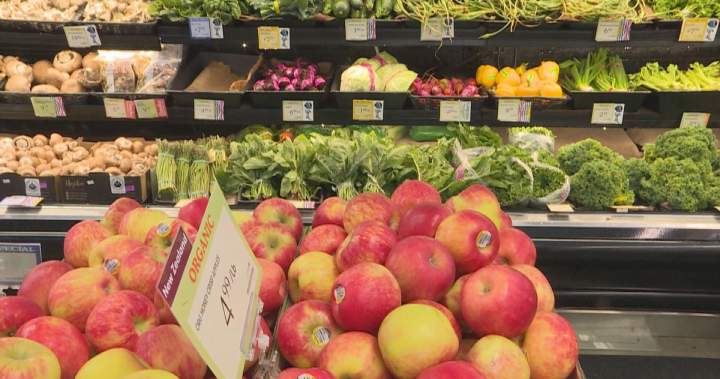Canadian households struggling with the high cost of things like mortgages, auto loans and others impacted by interest rates could see some relief soon if the Bank of Canada cuts rates Wednesday.
Although this may be good news for household affordability, experts warn food prices are likely only going to continue going up — a warning that comes as food banks across Canada highlight a sharp rise in demand.
Economists have suggested the central bank could cut its overnight benchmark lending rate on Oct. 29 by 25 basis points, which would be its second cut since March.
This would effectively lower costs for some consumers with variable rate loans like a mortgage, or those applying for loans that could see lower rates, and allow them to spend more on essentials like food.
“If tomorrow there’s a cut, it’s absolutely going to help consumers to show up at the grocery store with more money in their pockets because right now what you see in Canada is a very frugal food market — everyone is looking for bargains,” says Sylvain Charlebois, director of the Agri-Food Analytics Lab at Dalhousie University.
“It’s a trading-down economy when it comes to food right now in Canada, just because people have no money. So if the Bank of Canada can help, it will be welcome.”
Although this may be good news for household budgets, getting food prices to come down may be a much bigger challenge, as interest rates do not directly affect food prices.
“There’s not really a whole lot they (the Bank of Canada) can do about rising food prices, specifically ones that are driven by supply disruptions in key markets,” says Andrew Hencic, director and senior economist at TD Bank.
“The Bank of Canada will deliver another cut (on Oct. 29) by 25 basis points. It’s not big, but it’s something that, for consumers maybe will provide a little bit of relief — but again, it’s relatively small at this point.”
Statistics Canada reported consumer inflation, measured by the Consumer Price Index (CPI) for September was 2.4 per cent overall.
The September CPI measured prices for food bought in stores growing four per cent compared to a year earlier, and that compared to a 3.5 per cent reading in August.

Get daily National news
Get the day’s top news, political, economic, and current affairs headlines, delivered to your inbox once a day.
This means when factoring in the average for all consumer goods and services for sale in Canada in the month, food prices accelerated faster than almost all other categories.
One of the reasons this is happening has to do with supply, which includes how much food is available to sell from sources in Canada as well as internationally that get shipped in. If demand remains high, and there is less supply available to sell, then the higher prices become.
“There are a couple of categories that are experiencing supply crunches, particularly beef and coffee products. Prices for those items are up well into the double digits year on year, and that’s driving a lot of the inflation in the food basket,” says Hencic.
“So from the Bank of Canada’s perspective, there’s not a whole lot they can do to provide relief on the supply front for beef and coffee markets.”
Statistics Canada’s data shows the average price for beef increased by about five per cent in September 2025 compared to a year prior, which increased the overall inflation reading.
“Beef is pushing food inflation higher. It’s a major component of the food inflation rate, and we don’t see how beef prices will drop before mid-2027,” says Charlebois.
“And the reason is just because there’s no inventory. Cattle ranchers are selling off and they’re not replenishing their herds. So that’s really affecting Canadians.”
Items shipped from overseas to Canada which are also high in demand like coffee and cocoa are vulnerable to supply disruptions like extreme weather that could mean increasing costs.
“There were some price pressures earlier in the year certainly for chocolate prices for instance, those are related to disruptions to growers,” says Hencic.
“Supply disruptions in the way of extreme weather or other events can impact the supply of these key food commodities, which are prone to some pretty large price moves like what we’re seeing now, particularly beef and coffee.”
The ongoing trade war with tariffs imposed by the United States and China may also play a factor for some prices, with Metro reporting some of its suppliers were increasing prices because of tariffs.
However, Hencic notes how tariffs may have minimal effect on prices paid at grocery stores in Canada now that most counter-tariff measures have been removed.
Although lower interest rates set by the Bank of Canada don’t have a direct effect on food prices, there are ripple effects which could improve affordability for Canadian households, and empower consumers to be able to buy more essentials.
Lower borrowing costs may not only give consumers some wiggle room in their bank accounts, but also incentivize businesses and investors to boost the Canadian economy.
Following its rate cut in September, the Bank of Canada noted how it decided to lower borrowing costs because “businesses reported that they are in a wait-and-see mode, given the unpredictability of U.S. trade policy.”
This means another rate cut will not only help out some consumers, but businesses may be inclined to expand operations, which could lead to more hiring and help to bring down the unemployment rate.
“If interest rates drop, what we’re expecting is to see more companies pick up the pace and invest, and that’s what we need,” says Charlebois.
“Because of what’s happening with the U.S., a lot of companies are just parking their money. They’re just not moving. They’re waiting, and you need to incentivize them to reinvest again in the economy.”
© 2025 Global News, a division of Corus Entertainment Inc.
Read the full article here














